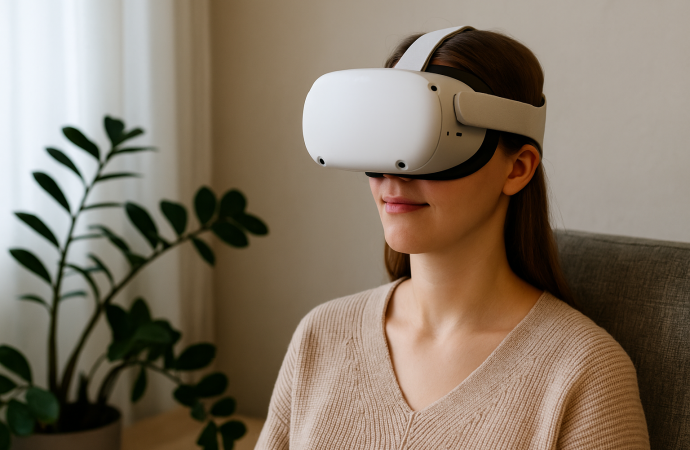Introduction In a world where mental health challenges are growing, access to care remains limited, and traditional therapy can feel daunting or inaccessible , VR mental health companies are quietly stepping in to change the game. These companies are using immersive technology to support people battling anxiety, depression, PTSD, phobias, burnout, and more. They’re not
Introduction
In a world where mental health challenges are growing, access to care remains limited, and traditional therapy can feel daunting or inaccessible , VR mental health companies are quietly stepping in to change the game.
These companies are using immersive technology to support people battling anxiety, depression, PTSD, phobias, burnout, and more. They’re not replacing therapists or doctors they’re enhancing care by creating new ways to engage, heal, and recover. With virtual reality, mental health is no longer confined to a clinic room. It’s becoming more personal, more engaging, and more empowering.
So, what exactly are VR mental health companies doing and why is their work so important right now?
What Are VR Mental Health Companies?
VR mental health companies develop virtual reality experiences and platforms designed to support emotional well-being, psychological resilience, and therapeutic intervention. These companies work with therapists, psychologists, and neuroscientists to build evidence-based virtual tools that help people:
- Calm anxiety and regulate emotions
- Revisit and reframe trauma in controlled settings
- Manage stress and burnout
- Practice mindfulness and grounding techniques
- Build emotional resilience and self-awareness
Unlike traditional therapy, VR offers a fully immersive environment, allowing users to step into serene landscapes, interact with calming elements, or safely confront triggering scenarios all while guided by therapeutic intent.
Companies like CogniHab, Limbix, Oxford VR are some of the names making this possible, each focusing on specific aspects of mental well-being and clinical support.
Why Mental Health Needs VR Now
Mental health services are facing a global crisis:
- Over 970 million people worldwide suffer from a mental health or substance use disorder (WHO, 2023).
- There’s a shortage of mental health professionals, especially in rural and underserved areas.
- Stigma still prevents many from seeking help.
- Burnout, screen fatigue, and workplace stress are rising sharply.
VR bridges many of these gaps. It removes barriers like location, stigma, or clinical discomfort.
How VR Mental Health Companies Are Making a Difference
1. Immersive Exposure Therapy
engagement through immersion. When users put on a VR headset, they’re not watching a screen they’re inside the experience.
This shift in experience makes therapy more accessible, non-judgmental, and even enjoyable.
Exposure therapy is used to treat phobias, PTSD, and anxiety by gradually and safely exposing patients to the source of their fear. Traditionally, this is done through imagination or real-life exposure both of which have limitations.
With VR, patients can be placed in highly controlled environments that simulate fears like flying, public speaking, or crowded spaces all while remaining safe.
2. Stress and Anxiety Relief Through Guided VR Journeys
Sometimes, the mind needs a break. Companies like CogniHab design VR mindfulness for stress relief and anxiety management. These are not games they’re calming, meditative experiences rooted in therapeutic design.
Users can take a mystical journey through nature, balance their energy with chakra healing visuals, or engage in breath-based activities all designed to lower heart rate, reduce cortisol levels, and build emotional regulation.
In corporate environments, these VR modules are being adopted as part of workplace wellness programs to help employees manage stress and prevent burnout.
3. Mental Health Support for Teens and Young Adults
The youth mental health crisis is real. Teenagers are facing record levels of anxiety, depression, and social isolation.
VR mental health companies like Limbix are designing interactive therapeutic experiences specifically for teens, helping them understand their emotions, cope with stress, and learn CBT (Cognitive Behavioral Therapy) techniques in a way that feels native to their digital lifestyle.
This is critical because the more engaging and accessible mental health support becomes, the more likely young people are to actually use it.
4. Post-Traumatic Stress and Veteran Care
Veterans and trauma survivors often struggle with long-term PTSD symptoms. VR therapy has shown great promise in this space.
Using VR exposure therapy, patients can revisit difficult memories in a controlled, therapeutic setting with the guidance of a trained professional. Over time, this can reduce the emotional intensity associated with the trauma.
BehaVR, for instance, integrates biofeedback with immersive environments to help users understand how their body responds to stress and teach them how to manage it in real time.
5. Accessible Therapy in Underserved Areas
Not everyone has access to a mental health professional. VR mental health platforms can be deployed in remote clinics, schools, rehab centers, or even at home, allowing individuals in rural or underserved areas to receive guided support without needing constant supervision.
Some companies are also exploring AI-powered virtual therapists within VR environments, making basic mental health support more scalable while still backed by clinical research.
Are VR Mental Health Solutions Effective?
Early research is highly promising:
- Studies show that VR therapy can be just as effective as in-person exposure therapy for phobias.
- VR meditation sessions have been shown to reduce anxiety, lower heart rate, and improve mood more effectively than traditional video or audio-guided meditations.
- PTSD patients have reported improved outcomes and increased comfort using VR compared to conventional methods.
While it’s not a one-size-fits-all solution, VR is proving to be a valuable complement to existing mental health care especially for those resistant to or disconnected from traditional formats.
The Role of CogniHab in VR Mental Wellness
Among the rising leaders in this space is CogniHab, a health-tech company that develops immersive therapy modules for anxiety, cognitive rehabilitation, and emotional resilience.
What sets CogniHab apart is its clinical grounding. The company works closely with medical professionals and behavioral experts to design VR journeys and exercises that aren’t just calming; they’re rooted in science.
Their Anxiety Relief Suite, for example, includes calming VR journeys like “Mystical Forest,” “Chakras Healing,” and “Balloon Blast” all designed to support emotional regulation and mindfulness, especially in high-stress environments like workplaces or rehab centers.
Whether for use in hospitals, corporate wellness rooms, or personal recovery, CogniHab is making mental wellness immersive, accessible, and user-friendly.
What’s Next for VR Mental Health Companies?
As technology continues to evolve, the future of VR in mental health will likely include:
- AI-driven emotional coaching in virtual environments
- Emotion-sensing VR systems that adapt experiences in real-time
- VR group therapy rooms where users can interact in safe, guided sessions
- Insurance-covered VR therapy sessions as outcomes continue to be proven
The possibilities are growing, and with them, the hope for more personalized, empathetic, and effective mental health support.
Final Thoughts
Mental health care is no longer limited to clinics and couches. With VR, it’s entering living rooms, workplaces, and communities in ways we’ve never seen before.
VR mental health companies are not just innovating they’re offering a lifeline. For millions who find traditional therapy intimidating, inaccessible, or ineffective, VR creates a new path forward.
And companies like CogniHab are showing that when technology meets compassion, healing becomes immersive, empowering, and within reach.
Read more healthcare blogs:






















